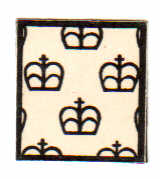
Great Britain
'Wilding' Postage stamps issued 1952-1967 during
the reign of Queen Elizabeth II

|
Great Britain |
|
Sheet markings on the Wilding issues, including cylinder numbers, marginal arrows, punch holes, colour registrations, sheet numbers.
Compared to the George VI period a wide variety of markings have been introduced in the Elizabethan issues to facilitate new elements such as registration of multicoloured stamps, ensuring that the cylinders are applied in the correct sequence, aids to registration of perforation, colour dots to ease checking for omission of colours and so on. The writing on the margins on these illustrations have been applied only to the scanned images, not on the stamps themselves. For the next page in this sequence, click on one of the titles listed below. Click on the back arrow in the top toolbar to return to the previous page. The first years 1952-1955 1955-1960 definitives and commemoratives 1961-1966 commemoratives & postage dues Definitive stamps inverted watermarks Coil stamps and leaders Sheet markings Stamps in booklets Overprinted stamps Varieties Return to Introduction |
|
Copyright 2012 By EARS Leisurewrite |
Contact us here Return To our Home Page OR Return to our Stamps page |